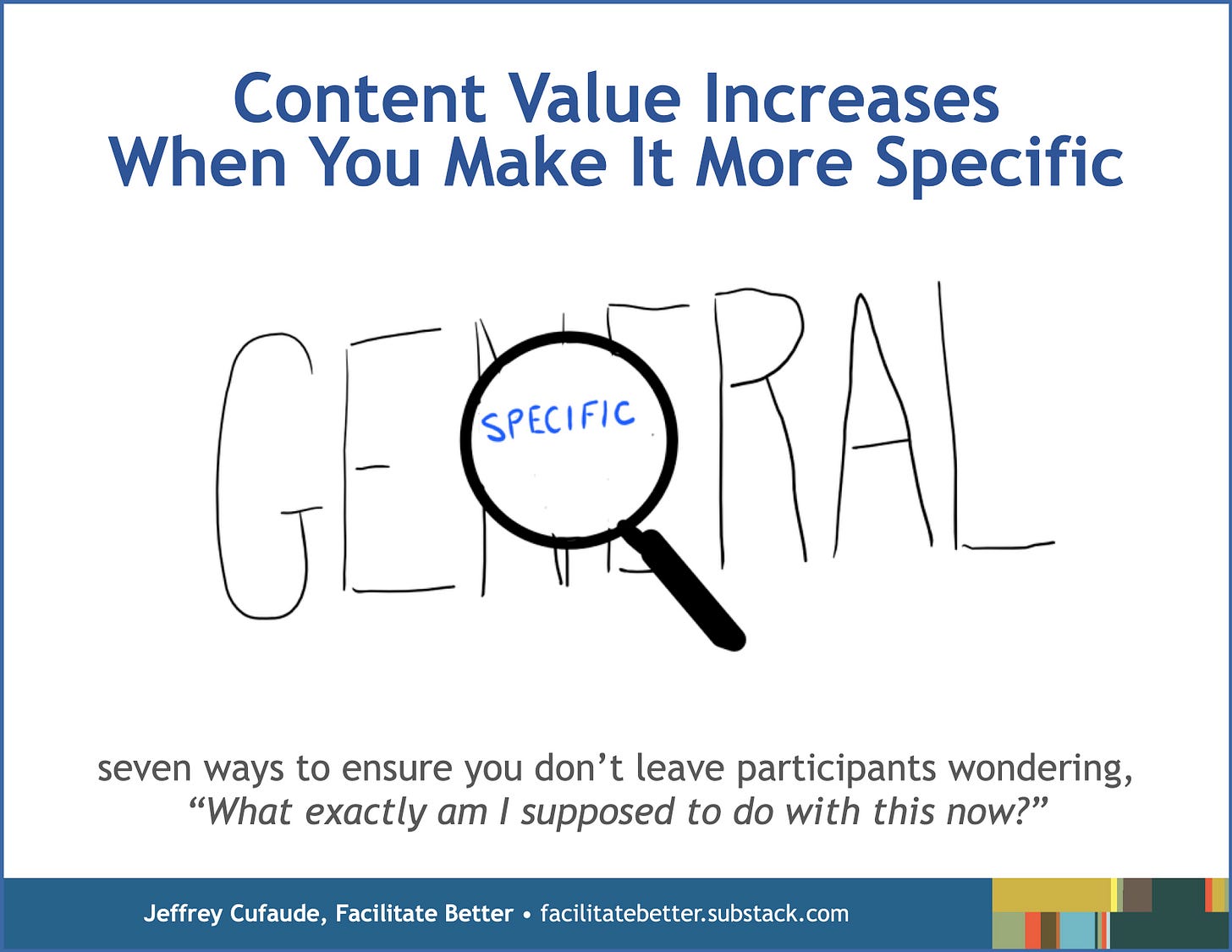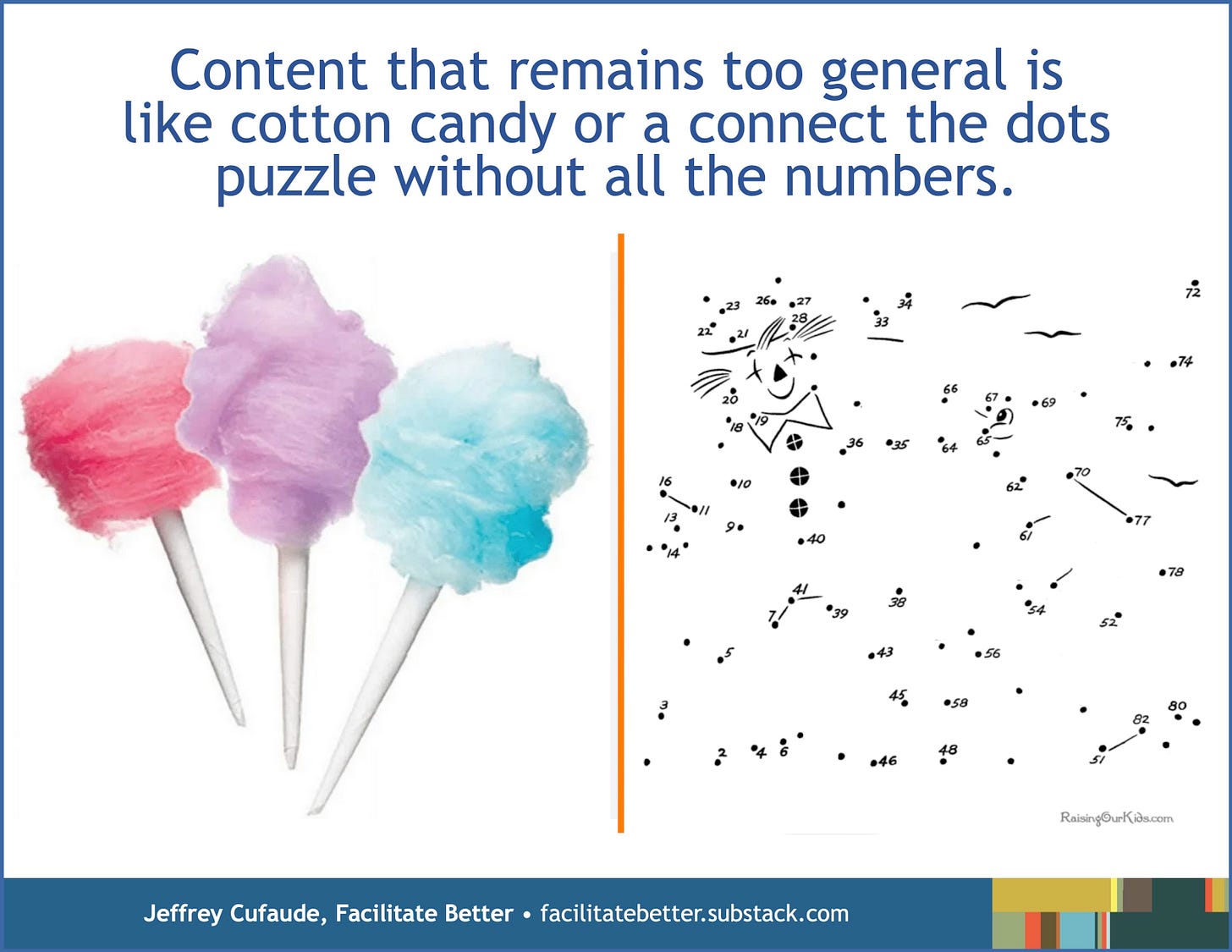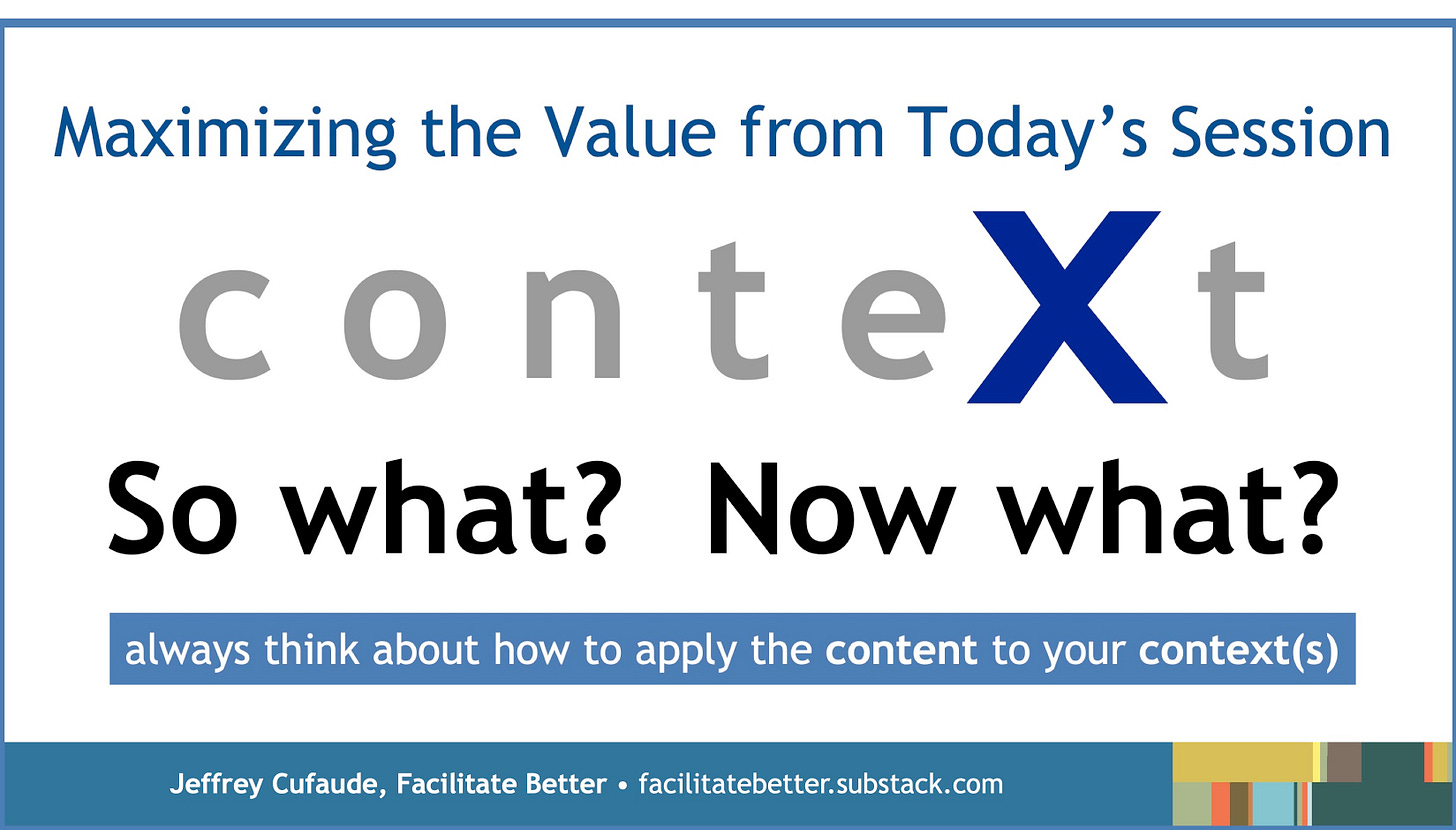Content Value Increases When You Make It More Specific (Facilitation Friday #59)
Raising awareness is good. Enabling meaningful action is better.
A good meeting, workshop, or general session keynote contains useful content. The best make it easier for participants to apply and retain it.
When this does not happen, the experience reminds me of cotton candy. Looks pretty. Tastes sweet. Dissolves quickly. Gives you a momentary sugar high. The session may temporarily raise awareness, but it doesn’t lead to much action.
Another way to think of insufficiently specific content is a “connect the dot” drawing that lacks all the numbers. All the “content” is there, but you lack everything needed to make the connections and get the final picture.
This is easy to prevent! Kolb’s Experiential Learning Cycle can help inform your thinking on this matter. The goal? Session design and facilitation that ensures participants are not left thinking, “Good stuff, but what am I supposed to do with this?”
Why some leave content too general
In coaching speakers and facilitators on this issue, I’ve discovered three primary reasons why they may not help participants derive their content’s full value:
They don’t realize some participants may need assistance applying content. Often, the presenter naturally makes those connections and/or has ingrained personal habits during meetings and workshops to capture and apply relevant information.
They pack in so much content that little time remains to help participants make sense of what has occurred and to apply it for their own specific purposes.
They lack knowledge of (or experience using) tools, techniques, and processes that engage participants in meaningful exploration and application of content.
Defining success
How would you define success for a meeting or workshop in terms of helping participants make the content more specific and more actionable?
My definition would be something like this:
A successful session includes meaningful tools and sufficient time that make it easier for participants to recall and retain retain the content, integrate it into their efforts, and achieve their desired outcomes.
Whatever your definition, achieving it usually requires more than just cramming in five minutes at the end of the meeting or workshop for participants to consider what should happen next. Think about how you might open and close a session to help achieve your vision for success, as well as leverage the time in between.
Here’s a basic framework I often use in combination with a notetaking worksheet/learning journal similar to what I provided in my first Facilitate Better essay (see linked post for the PDF).
At the onset
Invite participants to share the responsibility of applying the session’s content to their specific context(s) as I do in the slide above. Ask them to think about the content of the meeting agenda or workshop outline and to identify a few specific contexts to which they will apply it. Explain any other tools and the times in the session you’ll provide to help participants connect and apply the content.
During the session
Pause at one or more strategic points and ask participants to consider these two questions:
1. Implications: So what? Why or how does this matter? In general? For you? For others?
2. Applications: Now what? What might you (or others) wish to do differently? How might you apply this information?
Have them note responses and/or use a simple think-pair-share approach to answer these questions for themselves and to then learn what implications and applications others identify.
Note: this During the Session content was also shared in a previous post on making and inviting connections.
At the conclusion
Have participants reflect on all the session content one last time and identify any additional takeaways, their implications, and their applications.
They then should review all their notes and identify the two or three most relevant items they wish to focus on integrating into their efforts. For each one, ask them to do one or more of the following:
Identify a setting or situation where they want to show up differently and what specifically this would look like in action. Example: at our next team meeting I want to make at least two facilitative contributions as a participant.
Identify one specific change to make or habit to adopt and how they will initially sustain it for 30 days. Example: I will spend at least 15 minutes daily reading content related to my current professional goals and responsibilities.
This three-minute TED Talk helps explain why 30 days.
Identify actions to implement/steps to take after this event concludes using the specified timeframes. Example: the next day, the next week, the next month, and the next quarter.
A note about action planning
If you’re facilitating a meeting or planning session, it likely will need attention to action planning (identifying who will do what and when) at the onset, during, and at its conclusion to ensure the right things happen in the right sequence once people depart.
While this post intentionally did not address the various ways to do so, at minimum I find value in real-time recording (using flipcharts or a displayed document in-person; using a whiteboard or a displayed document virtually) that documents:
decisions made and/or goals set
how, when, and by whom this information will be communicated
other next steps, deadlines, and who is responsible
Ample templates are available online for this type of documentation.
More options to increase specificity and content value
Completing a worksheet—either individually or collectively—like the one spotlighted is an easy option anyone can implement to help increase the specificity and applicability of content. But we must do more.
In an earlier essay about the importance of active learning, I noted that:
“Effective session design and facilitation privileges processes and formats that actively engage both introverted and extroverted participants in order to maximize their attention, energy, knowledge, and insights.”
To that end, I offer my “cheat sheet” describing additional simple tools, techniques, or formats I often use to actively engage participants in applying content to their context(s):
Two-Minute Drills; IGNITE or Pecha Kucha talks
Affinity Groups or Commonality Clusters
Case Studies
Reactor Panel
Do More/Do Less
Learning/Application Worksheets
These options generally are adaptable for sessions of varying lengths and numbers of participants. While they may work best in person, I have used each successfully in virtual or hybrid sessions. You can add your own in the space provided.
Bottom Line
Content’s real value is determined after a meeting, workshop, or conference when participants try to recall and successfully apply it in their own efforts. Effective session design and facilitation integrates adequate time and attention to jumpstart that process and help participants make relevant connections of the content to their own context(s).
Getting in Action
How might you better “bookend” a meeting, workshop, or conference at its start and conclusion to make it easier for participants to reflect on and apply what transpires in between?
On the cheat sheet provided, add one or more ways you use (or you’ve seen others use) to help participants make sense of content and make it more actionable for their needs.
Take the outline for a meeting or workshop you have facilitated or will facilitate. Select one or more of the cheat sheet options to incorporate, adapting it appropriately for the session’s outcomes, length, setting, and the number and nature of its participants.
© Facilitate Better and Jeffrey Cufaude. All rights reserved.
To affordably license this content for reprint on your site or in electronic or print communications or to contact me regarding customized facilitation skills workshops or consultations, complete this form.







